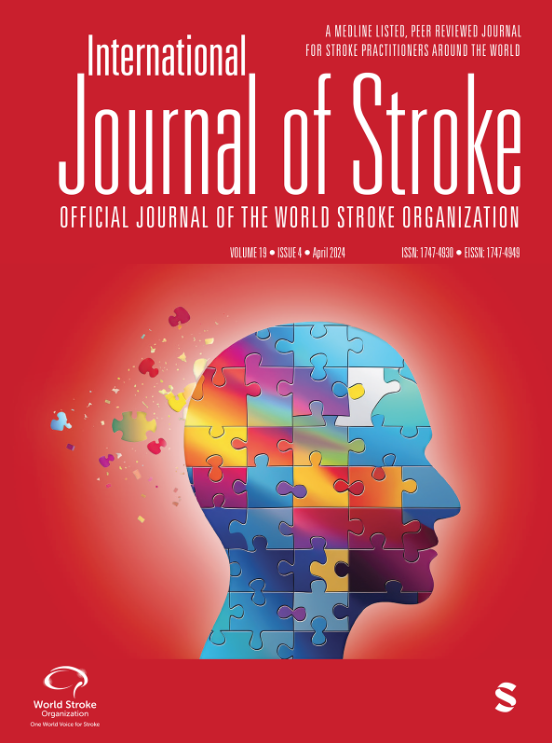A Randomized Controlled Trial of Tenecteplase Versus Standard of Care for Minor Ischemic Stroke With Proven Occlusion (TEMPO-2): Rational and design of a multicenter, randomized open-label clinical trial.
IF 6.3
2区 医学
Q1 CLINICAL NEUROLOGY
引用次数: 0
Abstract
Background:Almost half of acute ischemic stroke patients present with mild symptoms and there are large practice variations in their treatment globally. Individuals with an intracranial occlusion who present with minor stroke are at an increased risk of early neurological deterioration and poor outcomes. Individual patient data meta-analysis in the subgroup of patients with minor deficits showed benefit of alteplase in improving outcomes, however, this benefit has not been seen with intravenous alteplase in published randomized trials.Design:TEMPO-2 (A Randomized Controlled Trial of tenecteplase Versus Standard of Care for Minor Ischemic Stroke With Proven Occlusion) is a prospective, open label with blinded outcome assessment, randomized controlled trial, designed to test the superiority of intravenous tenecteplase (0.25mg/kg) over non thrombolytic standard of care, with an estimated sample size of 1274 patients. Adult patients presenting with acute ischemic stroke with NIHSS <5 and visible arterial occlusion or perfusion deficit within 12 hours of onset are randomized to receive either tenecteplase (0.25 mg/kg) or standard of care. The primary outcome is return to baseline neurological functioning, measured by the modified Rankin Scale (mRS) at 90 days. Safety outcomes include death and symptomatic hemorrhage (intra or extra-cranial). Other secondary outcomes include mRS 0-1, mRS 0-2, ordinal shift analysis of the mRS, partial and full recanalization on follow up CT Angiogram.Conclusion:Results of this trial will aid in determining whether there is benefit of using tenecteplase (0.25mg/kg) in treating patients presenting with minor stroke who are at high risk of developing poor outcomes due to presence of an intracranial occlusion.Trial Registry Name:A Randomized Controlled Trial of tenecteplase Versus Standard of Care for Minor Ischemic Stroke With Proven Occlusion, Registration number: NCT02398656; URL: https://clinicaltrials.gov/study/NCT02398656 .特奈替普酶治疗轻微缺血性中风伴确诊闭塞的标准疗法与特奈替普酶治疗轻微缺血性中风的标准疗法的随机对照试验(TEMPO-2):多中心、随机、开放标签临床试验的原理与设计。
背景:近一半的急性缺血性卒中患者症状轻微,全球范围内对他们的治疗存在很大差异。颅内闭塞的轻微卒中患者早期神经功能恶化和预后不良的风险增加。对轻微功能障碍患者亚组的单个患者数据进行的荟萃分析表明,阿替普酶可改善预后,但在已发表的随机试验中,静脉注射阿替普酶并未显示出这种益处。设计:TEMPO-2(阿替普酶与已证实闭塞的轻微缺血性脑卒中标准治疗方法的随机对照试验)是一项前瞻性、开放标签、结果评估盲法的随机对照试验,旨在检验静脉注射阿替普酶(0.25 毫克/千克)与非溶栓标准治疗方法相比的优越性,预计样本量为 1274 例患者。急性缺血性脑卒中患者在发病 12 小时内出现 NIHSS <5、可见动脉闭塞或灌注缺失,将随机接受替奈普酶(0.25 毫克/千克)或标准治疗。主要结果是90天后神经功能恢复到基线水平,以改良Rankin量表(mRS)衡量。安全性结果包括死亡和症状性出血(颅内或颅外)。其他次要结果包括 mRS 0-1、mRS 0-2、mRS 的顺序移动分析、随访 CT 血管造影的部分和完全再通。这项试验的结果将有助于确定使用替奈普酶(0.25mg/kg)治疗因颅内闭塞而极有可能导致不良后果的轻微脑卒中患者是否有益:NCT02398656; url: https://clinicaltrials.gov/study/NCT02398656 .
本文章由计算机程序翻译,如有差异,请以英文原文为准。
求助全文
约1分钟内获得全文
求助全文
来源期刊

International Journal of Stroke
医学-外周血管病
CiteScore
13.90
自引率
6.00%
发文量
132
审稿时长
6-12 weeks
期刊介绍:
The International Journal of Stroke is a welcome addition to the international stroke journal landscape in that it concentrates on the clinical aspects of stroke with basic science contributions in areas of clinical interest. Reviews of current topics are broadly based to encompass not only recent advances of global interest but also those which may be more important in certain regions and the journal regularly features items of news interest from all parts of the world. To facilitate the international nature of the journal, our Associate Editors from Europe, Asia, North America and South America coordinate segments of the journal.
 求助内容:
求助内容: 应助结果提醒方式:
应助结果提醒方式:


